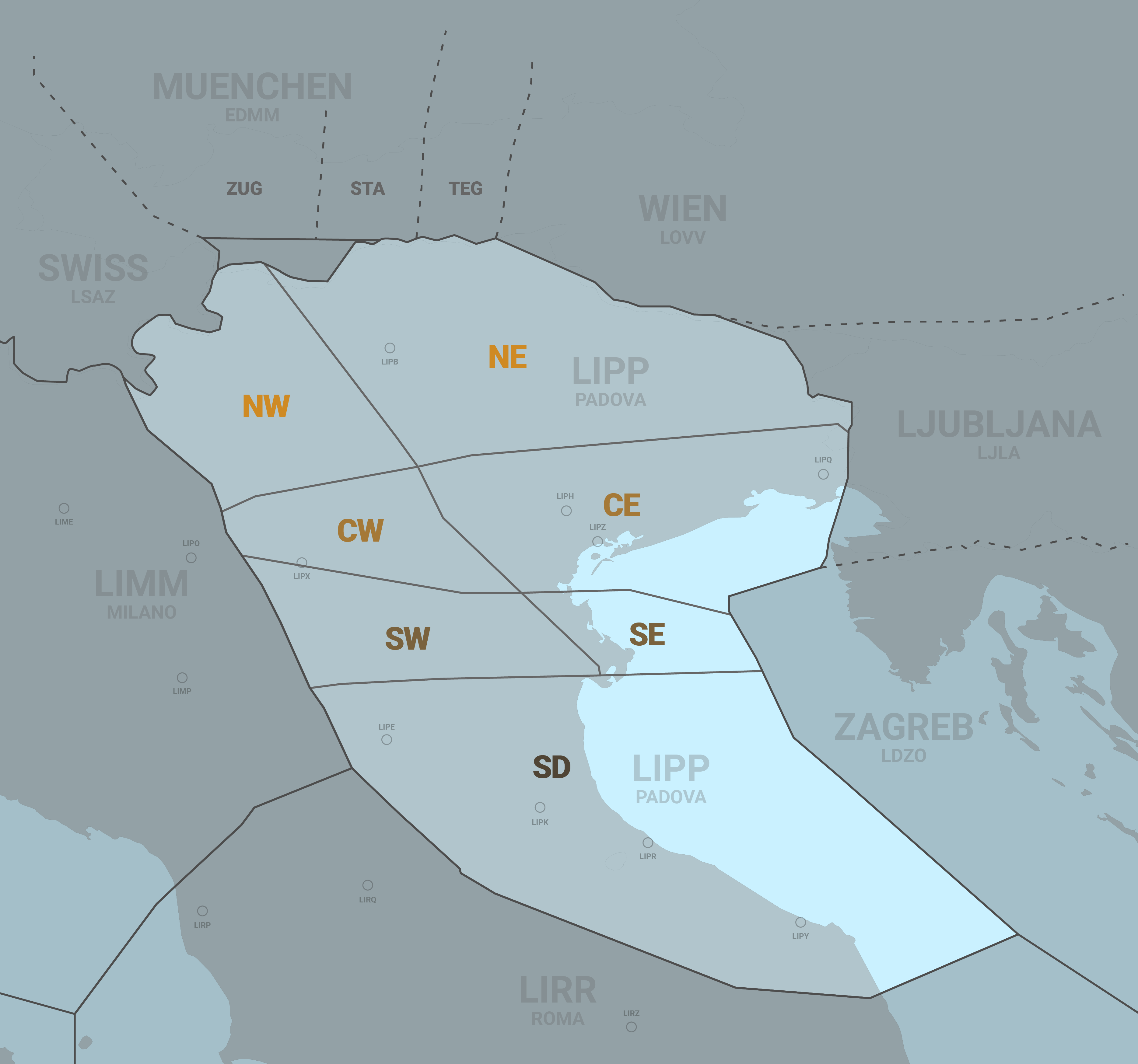¶ Padova ACC
¶ Modules
Padova ACC is split in 7 modules and 2 further modules located within the CE and SE modules (CE0 and SE0)

¶ Vertical structure
Each of the 7 modules is vertically split into 7 layers + 1 (CE0 and SE0), according to the following table:
¶ Configurations
The master sector is always LIPP_CE1_CTR, if an additional ATCO comes online, the first split can be made either laterally of vertically, according to the following tables:
Further ATCOs may split the lower sectors further or split the upper sector, according to the following tables:
Additional configurations are possible and will be used tactically to meet traffic demand at specific events
¶ Silent procedures
These silent procedures describe the automatisms to be applied when handling departing and arriving aircraft to/from the LIPP area and neighbouring stations, the transfers described shall be made to the operating sector controlling the specified module. The silent procedures can always be overridden by coordinations considered more appropriate based on ongoing the traffic situation.
When the agreed level is “XFL” a silent level coordination shall be sent using EuroScope.
¶ Operating techniques
¶ LIPZ arrivals
Arrivals into LIPZ are handled by:
- OTGIG -> SW1
- BASOG -> SE1
- ALBET -> CW1
Direct to ALBET may only be assigned after coordination with the sector absorbing the CW1 module
¶ LIPH arrivals
Arrivals into LIPH are handled by:
- INBUT-ROVIG -> SE0
- VIC-RAXHO -> CE1
Arrivals via LUMAV-ALBET are subject to coordination with the sectors absorbing the CW1 and CE1 modules, traffic will be handled with XFL
¶ LIPE arrivals
Arrivals via ADOSA-BENUS can be descended by the CW1 and SW1 modules inside Milano ACC AoR in accordance with the delegated airspace established in the LIMM-LIPP LoA
¶ LIPB arrivals/departures
-
The first sector in contact with an IFR arrival into LIPB (controlling layers 1/2) shall request the pilot’s intended approach procedure. This information must then be relayed to NW1, the sole sector responsible for managing approaches at LIPB.
-
NW1 will relay to the FIC the intended approach, ETO FORER and eventual holding over FORER with the estimated approach time. In case of departures, NW1 will inform the FIC when the ICP is free of traffic. The FIC will relay these information to Bolzano AFIU.
-
NW1 will ask the pilot to report when ready to start the approach and then:
- Clear to the lowest FL within controlled airspace
- Instruct the aircraft to exit controlled airspace
- Inform the pilot of the termination of radar service
- Instruct the pilot to contact Padova FIC
In cases of multiple IFR inbound and outbound movements at LIPB, only 1 IFR aircraft at a time is permitted within the “Valle dell’Adige” (as defined in the AIP). This restriction applies to both arrivals and departures.
Successive departures or arrivals will be instructed to remain on the ground or hold at a suitable FL, informing of the reason for the delay and the estimated wait.
Aircraft may depart or start the approach only after receiving the report that the preceding aircraft has vacated the runway or the published ICP.
VFR aircraft shall be informed of the presence of IFR aircraft and instructed to remain outside the published procedures’ path
¶ SE0-CE0 SOP
¶ Area of responsibility
SE0 provides the approach control function for LIPZ, CE0 provides the approach control function for LIPQ
Unless LIPQ_CE0_APP is online, the two sectors are bandboxed under LIPZ_SE0_APP
The vertical limit of both sectors is FL135
¶ Radar separation and spacing
The minimum radar separation to be applied in the SE0 and CE0 sectors is 5 NM.
SE0 shall aim to obtain a spacing of 9 NM on final approach, spacing may be reduced to 6 NM prior coordination with the Tower and in the absence of departures.
¶ Speed restrictions
Aside from the published STAR speed constaints SE0 shall assign speed restrictions using the following scheme:
200 Knots:
- Starting the turn to intercept the LOC or
- Until 12 NM from runway threshold in case of straight in approach
180 Knots:
- Once established on the LOC or
- Until 8 NM from runway threshold
160 Knots:
- Until 5 NM from runway threshold
¶ Operational recomendation
SE0 shall aim to establish aircraft on final using the base-final vectoring technique keeping in mind that aircraft too far out may not be able to receive the localizer signal and should be cleared direct to waypoint LAREN or KIZAF
The glideslope can be captured at 4000 ft over waypoint KIZAF and at 5000 ft over LAREN
Southbound departures via CHI and AKADO may often cause conflicts with arrivals via the BASOG STAR, these conflicts are often resolved coordinating a tactical direct with LIPP_CE (usually to ANC)
CE0 shall aim to establish aircraft on final via CHI using the direct-to technique and all other arrivals using radar vectors
¶ FLAS
¶ Departures
| COP | XFL | TO SECTOR |
|---|---|---|
| VIC | FL100 | LIPP-CE1 |
| ROKIB | FL100 | LIPP-CE1 |
| CHI | FL130 | LIPP-SE1 |
| AKADO | FL130 | LIPP-SE1 |
| ROTAR | FL130 | LIPP-SE1 |
¶ Arrivals
SE0 will receive arriving aircraft already cleared for the RNAV1 STAR according to the following table:
| COP | PEL | FROM SECTOR |
|---|---|---|
| ALBET | FL110 | LIPP-CW1 |
| OTGIG | FL140 | LIPP-SW1 |
| BASOG | FL140 | LIPP-SE1 |
SE0 also manages some arrivals in LIPH and LIPQ:
| COP | PEL | TO SECTOR | XFL |
|---|---|---|---|
| INBUT | FL140 | LIPH-APP | 6000 |
| ROVIG | FL140 | LIPH-APP | 6000 |
| ROSKA | FL140 | LIPP-CE0 | FL100 |